Content
The compatibility of vegetables in the garden is a much more important issue than it might seem at first glance. Among plants, as well as among people, there are friends and enemies. The quality of the crop and, in general, the vital activity of certain plants can depend on the knowledge of these nuances. Let's figure out in more detail what to plant next to what.

Mixed landings
A special science - allelopathy - deals with the problems of plant interaction in the garden. Any plant releases a variety of substances into the soil and air, positively or negatively affecting the "neighbors". A useful and harmful neighborhood of vegetables in the beds is presented in the table below. In the meantime, consider the advantages of mixed planting technology:
- space in the garden is saved;
- the soil is less depleted, there is no need for an annual crop rotation;
- less effort is required to treat pests, since some plants themselves scare them away;
- when planting vegetables together in the beds, additional fertilizers are almost not required;
- the quality of the harvest and the palatability of the fruits are growing (for example, beans can make radishes tastier, and mint - white cabbage), as well as the amount of vitamins and sugars in them.
The rules to be followed when organizing combined planting of vegetable crops:
- The width of each bed should be more than a meter. This will be needed in the future for the convenience of caring for the plants.
- The bed is subdivided into several sections. In the central plant such crops are planted that grow and mature for a long time. These are peppers, cabbage, tomatoes. When the season comes, they will already occupy a good half of the ridge.
- Those types of crops that ripen quickly are planted from the edges. These are mainly greens, but also strawberries and grapes.
An example of a properly organized bed for joint plantings:
Lettuce grows on the edge, in the second row carrots or radishes alternating with marjoram, in the third row onions. 4th and 5th row correspond to 1st and 2nd. Cucumbers are planted in the middle.
You can think of a lot of similar schemes, it all depends on the plants you need and on your attentiveness in matters of their combination.
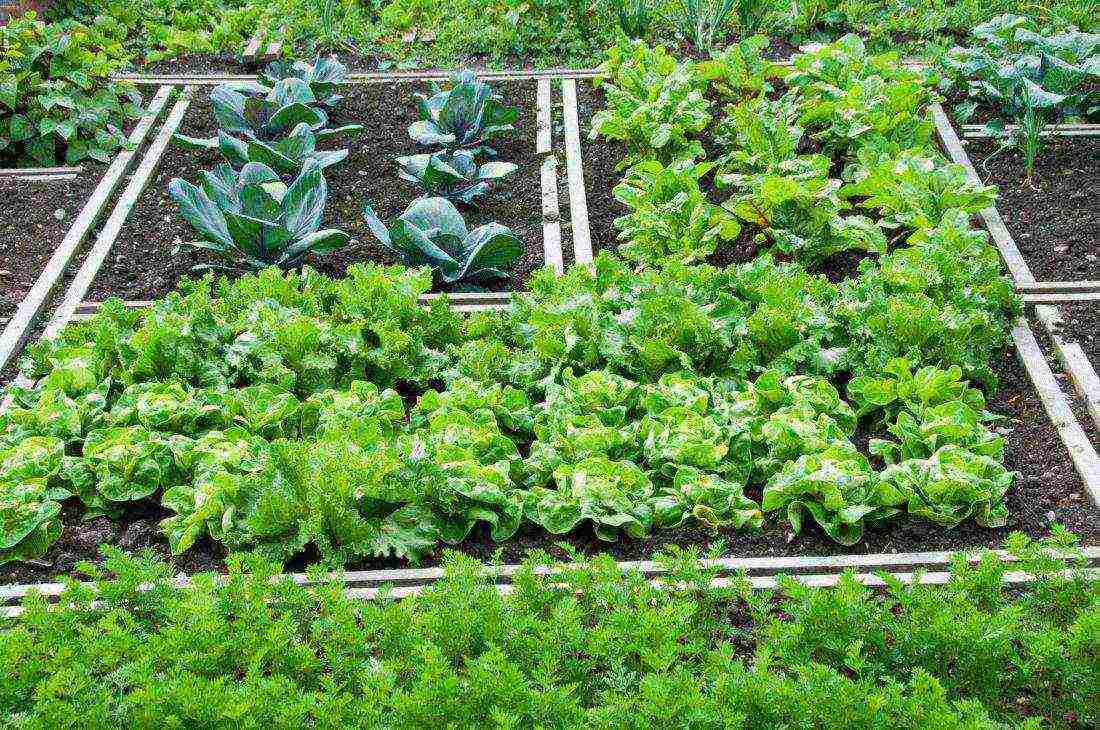
Neighborhood vegetables in the beds
Good neighbors are radishes, beans, lettuce, mint, dill, spinach. But tomatoes and cucumbers are not at all combined, since they require different amounts of moisture. Tomatoes also need a lot of fresh air, while cucumbers prefer the greenhouse effect. In general, tomatoes are not combined with almost any of the garden crops. The exceptions are radishes, asparagus, garlic, parsley.
Basil, on the other hand, is almost universal and can benefit any plant.
It is not recommended to plant cabbage next to beets, carrots, beans, and pumpkin will not be happy with potatoes. It is better to plant it with relatives - zucchini, squash or melons. Otherwise, the harvest will be much worse.
Useful neighbors of beets are cabbage, zucchini, legumes.
Peas go well with corn, lettuce and cabbage, but they don't feel very well if their neighbors in the garden are zucchini, onions, beans.
Ideal neighbors of dill are potatoes and parsley, cucumbers are eggplants, onions, lettuce.
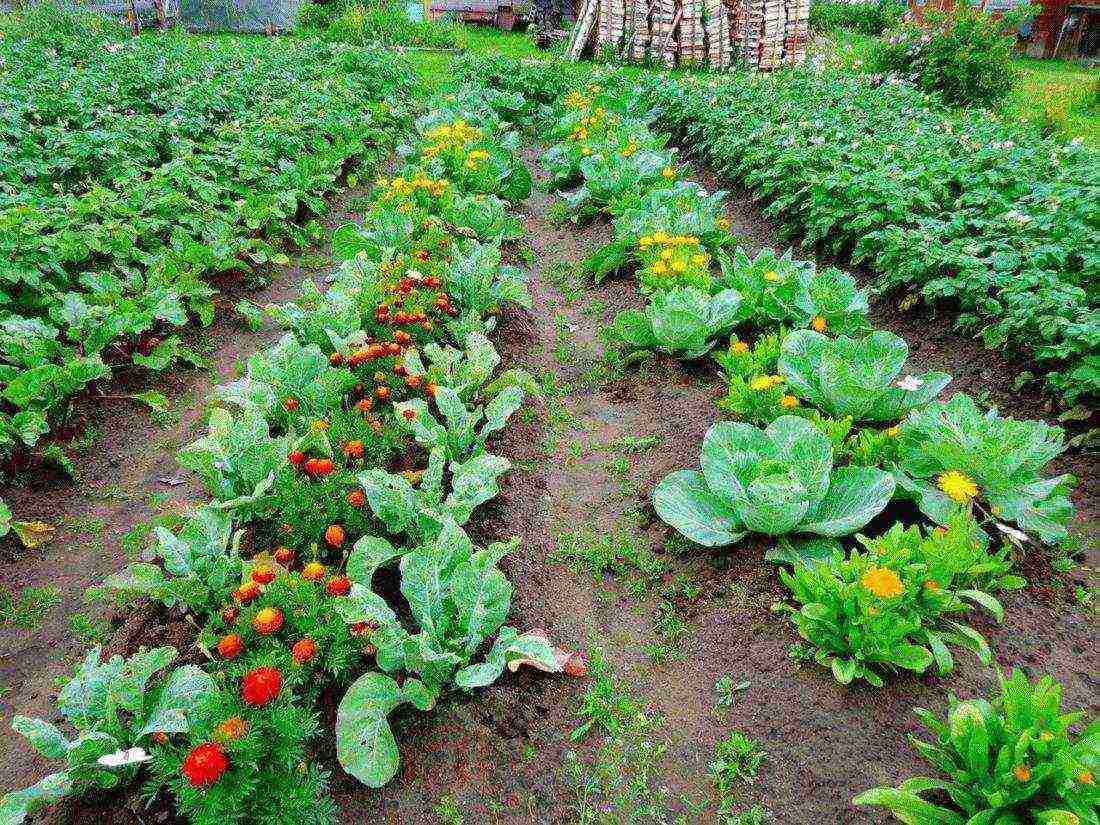
Potatoes are usually planted separately, away from other crops. But it should be borne in mind that horseradish will help protect it from bedbugs, and beans / peas or other legumes will saturate the earth with nitrogen, which will have a positive effect on the quantity and quality of the crop. They will also scare off Colorado beetles.
Every plant needs pollinators, which is why it is a good idea to plant flowers next to vegetables. In addition to flowers, marjoram, mint, lemon balm are also attractive to pollinating insects.These herbs will always be useful on the farm for culinary or medicinal purposes, and at the same time the yield of your vegetable crops will increase significantly. In addition, they wonderfully decorate the summer cottage.
Another important point: the presence of earthworms in the soil. They loosen the soil, thereby increasing the amount of oxygen in it. Worms are attracted by crops such as onions, valerian, chicory.
Spinach is a very convenient option for planting together because it releases a lot of saponin into the soil, a substance that promotes root growth and improves access to water and nutrients. Different types of primrose have the same property.
Table of compatibility of vegetables in the beds
More detailed data can be found in the tables below:

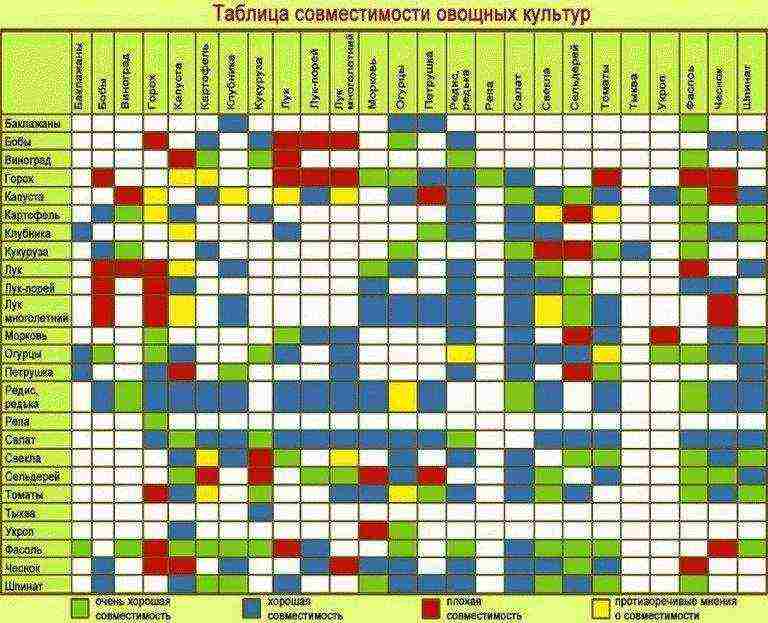
Examples of bad neighborhoods not included in the tables
When organizing joint planting of vegetables in the garden, make sure that the gooseberries are away from the currants, otherwise the moth, a pest dangerous for berries, will actively multiply.
A pear planted near a sweet cherry will often hurt. The same situation is observed when planting next to cherries or cherries of any kind of currant. A juniper planted under a pear is more likely to infect it with fungal infections.
The apple tree also loses from the proximity of cherries / cherries, as well as apricot, barberry, lilac. In general, sweet cherry reacts aggressively to any planting under its crown, especially trees.
To prevent a pest called strawberry-raspberry weevil, avoid planting strawberries and raspberries nearby. On the other hand, almost any other plants next to raspberries, on the contrary, feel better, because they saturate the earth with oxygen.
It is noteworthy that it is not advisable to plant a birch in your garden - it has a very strong root system that absorbs a huge amount of water, taking it away from other plants. The same can be said for maple and spruce.
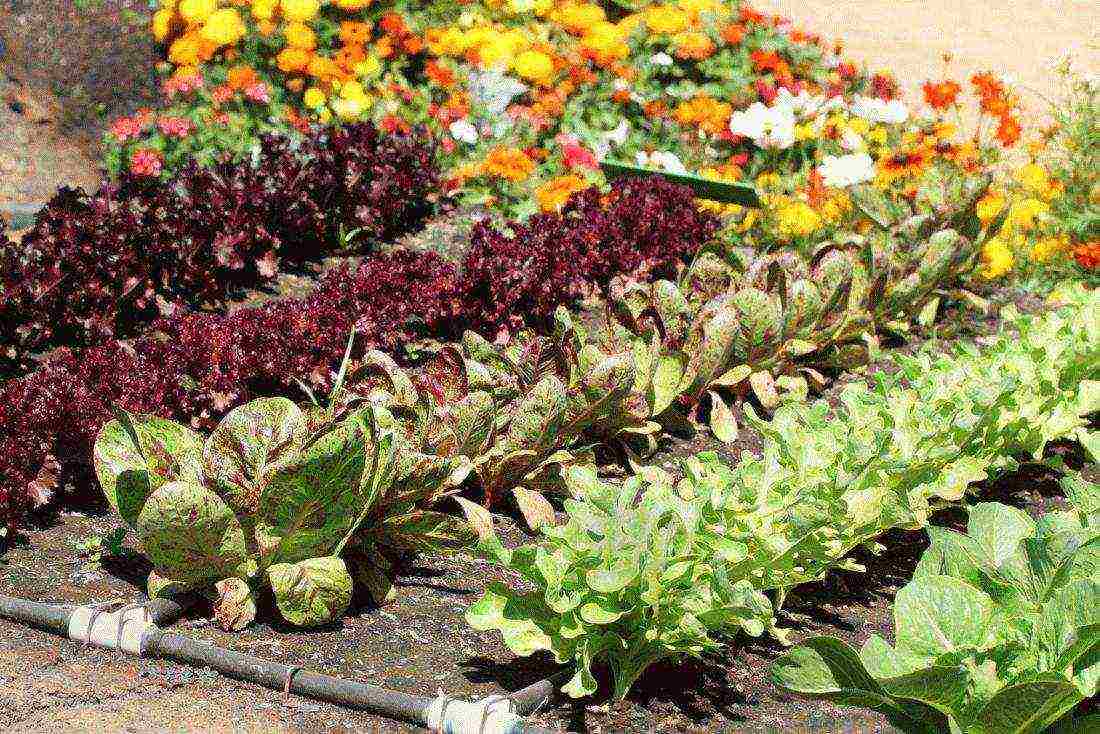
Plants that can repel pests:
Celery and makhorka resist the cabbage fly, and onions are an excellent remedy for spider mites. Wormwood and garlic are enemies of cruciferous flea beetles, and tomatoes are not to the liking of moths and copperheads. Garlic is also effective against aphids and helps the soil accumulate sulfur.
Neighborhood rules for vegetables for greenhouses
If the compatibility of vegetables is important to you when planting in a greenhouse, keep the following factors in mind:
- in greenhouses, vegetables grow faster, and in general, the harvest is better;
- in order to properly plant vegetables in a garden bed in a greenhouse, you need to adhere to the same principles as in the open field;
- before planting, you need to carefully develop a diagram of the beds;
- the cardinal points must also be taken into account - cucumbers and tomatoes grow better on the sunny south side.
Plant compatibility in a greenhouse garden bed is closely related to the season. There are two types of mixed greenhouse planting. In the first, greens are grown in early spring, in the second, different crops are cultivated throughout the season. In other words, first, greens are planted, which ripens very quickly, then they are harvested and tomatoes or cucumbers are planted in the same place.
In the greenhouse, it is advisable to plant those plants that require similar humidity and temperature conditions. Cucumbers give abundant shade, so shade-loving crops can be placed next to them. Tomatoes will do well with cabbage.
Mixed planting of vegetables will help you get a good harvest even in difficult conditions - poor soil, unsuitable climate. Mixed beds can be combined with compacted sowing technology for better results. In short, the creation of the garden of your dreams is in your hands, if you correctly use modern developments. Both the beginner and the experienced gardener can learn something new from mixed planting technology.
How to increase productivity in the country
The harvest can be bad for a variety of reasons that
do not depend on the gardener:
- weather;
- depleted soil;
- poor quality seeds;
- lack of plant nutrition.
Despite these factors, you can get an excellent harvest even under these conditions! Our readers successfully use a method that helps
increase productivity on your site several times!
…
Any piece of land can accommodate and feed the more living beings, the less their needs and interests collide with each other. K. I. Timiryazev.
Experts believe that between plants, as well as between people, depending on many natural factors, a wide variety of relationships are established. They can be friends and even protect each other from pests and diseases, they can simply tolerate someone's neighborhood, maintaining neutrality, but they can also compete with each other and even be at enmity, up to the physical destruction of an opponent.
Any household plot with a garden, a vegetable garden and flower beds located on its territory is a community of plants that live by their own rules and laws and which should be taken into account by both gardeners and gardeners. For example, experts believe that almost all cultures feel comfortable with raspberries. The fact is that this plant is a nitrogen fixer and enriches the soil with oxygen. They recommend planting an apple tree next to the raspberry, and so close that their branches can touch. With this arrangement, raspberries will protect the apple tree from scab, and that, in turn, will protect raspberries from gray rot. Good compatibility of barberry with honeysuckle and plum. Hawthorn maintains good neighborliness with cherries and cherries, but only on the condition that the distance between them is at least 4 m.
Grapes and pears get along well together. The tree does not suffer from the fact that it is entwined with grapes, and the grape vine feels good at the same time. Grapes with Chinese magnolia vine or actinidia are able to maintain a favorable relationship, so that these plants can be safely wrapped around a gazebo in a personal plot.
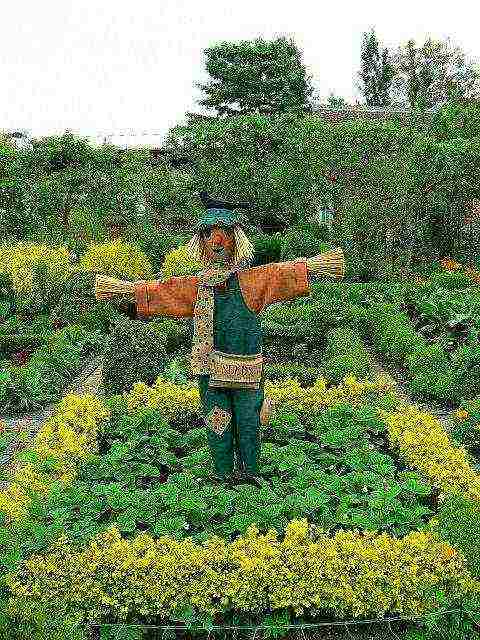 Scarecrow in the garden
Scarecrow in the garden
Here are some examples of unwanted plant neighborhoods in the garden.
Experienced gardeners know that a pear planted in close proximity to cherries or cherries will constantly hurt, and red and black currants will not grow next to plums, cherries or cherries.
The close proximity of gooseberries and currants provokes active reproduction of a pest dangerous for these plants - the gooseberry moth.
The apple tree reacts extremely negatively to the close proximity of apricot, cherry or sweet cherry, so it is better to avoid such combinations in the garden. Also, apple and pear do not like lilacs, viburnum, roses, chubushnik, barberry.
It is not recommended to place raspberries and strawberries close to each other, since their proximity leads to increased reproduction of the strawberry-raspberry weevil.
Negatively refers to everything that is under its crown, sweet cherry. For this reason, it is impossible to plant seedlings of any other trees under the cherry - they will be doomed to death.
It is not recommended to plant birch next to growing trees and shrubs, since its powerful root system consumes a lot of water and deprives nearby plants of moisture. Spruce and maple can have a similar effect.
Juniper should not be placed next to the pear, as it can infect the fruit tree with fungal diseases.
Compatible and incompatible crops in the beds.
The following table is based on long-term observations of experts from the Ecology Action group (based on the book "How to Grow More Vegetables" by John Jevans).
| Compatible | Incompatible | |
| eggplant | beans | |
| peas | carrots, turnips, radishes, cucumbers, corn | onions, garlic, potatoes, gladioli |
| cabbage | potatoes, celery, dill, beets, onions | strawberries, tomatoes |
| potato | beans, corn, cabbage, horseradish | pumpkin, cucumbers, tomatoes, raspberries |
| Strawberry | common bush beans, spinach, lettuce | cabbage |
| corn | potatoes, peas, beans, cucumbers, pumpkin | |
| onion garlic | beets, strawberries, tomatoes, lettuce, celery, carrots | peas, beans |
| carrot | peas, lettuce, onions, tomatoes | Dill |
| cucumbers | beans, corn, peas, radish, sunflower | potato |
| parsley | tomatoes, asparagus | |
| radish | peas, salad, cucumbers | |
| beet | bow, kohlrabi | |
| celery | onions, tomatoes, bush beans, cabbage | |
| tomato | onions, parsley | cabbage, potatoes |
| turnip | peas | |
| pumpkin | corn | potato |
| bush beans | potatoes, carrots, cucumbers, cabbage, celery, strawberries | onion garlic |
| spinach | Strawberry |
Note that there is other information about compatible and incompatible plants grown in the garden. We also cite it so that gardeners have the opportunity to choose:
- beans are compatible with cucumbers, potatoes, cabbage, swing lettuce, lettuce, radish, beetroot, rhubarb, tomatoes; incompatible with peas, garlic, onions;
- peas are compatible with cabbage, rock salad, carrots, radishes; incompatible with beans, potatoes, garlic, tomatoes, onions;
- strawberries are compatible with garlic, cabbage, rock salad, onions, radishes; no incompatible plant satellites specified;
- cucumbers are compatible with beans, garlic, cabbage, rock salad, celery, onions; incompatible with radishes and tomatoes;
- potatoes are compatible with cabbage and spinach; incompatible with peas and tomatoes;
- garlic is compatible with strawberries, cucumbers, carrots and tomatoes; incompatible with beans, peas and cabbage;
- cabbage is compatible with peas, cucumbers, potatoes, garlic, cabbage and leaf salads, onions, radishes, beets, celery, spinach and tomatoes;
- cabbage salad is compatible with beans, peas, strawberries, cucumbers, cabbage, onions, radishes and tomatoes; incompatible with celery;
- lettuce is compatible with cabbage, radishes, beets, rhubarb, tomatoes;
- leeks are compatible with strawberries, cabbage, rocked salad, carrots, celery and tomatoes; incompatible with beans and peas;
- radishes are compatible with beans, strawberries, cabbage, head and leafy salads, spinach and tomatoes, incompatible with onions;
- beets are compatible with cucumbers, lettuce and onions; incompatible with onions;
- rhubarb is compatible with cabbage, rocked and leafy salads and celery;
- tomatoes are compatible with garlic, cabbage, head and leaf salads, leeks, radishes, celery and spinach; incompatible with peas, cucumbers and potatoes;
- onions are compatible with strawberries, cucumbers, cabbage salad, carrots and beets; incompatible with beans, cabbage and radishes.
 Garden
Garden
Aromatic and medicinal herbs useful in the garden and in the beds.
This table is also compiled from the aforementioned book How to Grow More Vegetables. Although there is similar information that even medieval monks used aromatic and medicinal herbs in their gardens and orchards to improve the taste of fruits and vegetables, increase yields and repel pests.
| Compatible aromatic and medicinal herbs for the garden and vegetable garden | |
| Basil | Grows well with tomatoes, Improves the growth process and fruit flavor. Deters flies and mosquitoes |
| Marigold | Acts as a repellent against insects, including nematodes |
| Valerian | Nice to have somewhere in the garden. |
| Hyssop | Scares off the cabbage scoop, grows well with cabbage and grapes. Should not be grown with radishes. |
| Cat mint | Scares off earthen (garden) flea beetles |
| Quinoa white | One of the best weeds for extracting nutrients from the subsoil; good for potatoes, onions and corn |
| Linen | Grows well with carrots, potatoes; scares off the potato flea, improves the growth process and smell. |
| Lovage officinalis | Improves the taste and condition of plants if it is planted in different parts of the garden. |
| Melissa officinalis | Grow in different parts of the garden |
| Tubular monard | Grows well with tomatoes, improves flavor and growth |
| Mint, peppermint |
It grows well with cabbage and tomatoes, improves the general condition of plants, the taste of fruits, repels the white scoop of cabbage |
| Nasturtium | Grows well with radishes, cabbage and pumpkin crops; grow under fruit trees, repels aphids, bugs, striped pumpkin fleas. |
| Calendula | Grows well with tomatoes. Scares off the asparagus leaf beetle, tomato worm and all kinds of insects. |
| Sow thistle | In moderation, this weed promotes the growth of tomatoes, onions and corn. |
| Petunia | Protects legumes |
| Medicinal wormwood | Grows well with cabbage. Scares off the cabbage scoop. |
| Chamomile officinalis | Grows well with cabbage and onions. Improves growth and taste. |
| Thyme (thyme) | Scares off cabbage worm |
| Garden dill | Grows well with cabbage. Dislikes carrots. |
| Fennel | Grow outside your garden. Most plants don't like him. |
| Garlic | Grow around roses and raspberries. Scares off the Japanese crunchy. Improves the growth and condition of plants. |
| Sage | Grow with cabbage and carrots, keep away from cucumbers. Scares away cabbage scoop, carrot fly. |
| Tarragon | It is good to have a garden in different places. |
We believe that within the framework of one article, we still gave sufficient material (in fact, there is a lot of it) on the declared topic so that the workers of summer cottages have a choice: what is acceptable for them and what is not. We wish you every success!
P.S. As you can see from this information, the plant community is doing well. For them, even a science was defined that studies the influence of plants on each other - allelopathy. The situation is worse in the human community, because in case of quarrels, together they kill each other, and over the years it becomes more sophisticated - from cannons, tanks, planes, missiles, etc. (as a rule, for self-interest and greed for the sake of). But tell me, my friends, how can each of us plant the garden of our souls? In it, by the age of 20, we already felt the emergence of weak, but completely original and native sprouts of an independent world outlook. It doesn't matter with what properties the seeds germinated in each of us: something was passed on from our ancestors, something from the collective culture (morality) in which we managed to live. We accepted something from the ideology of the past with enthusiasm, doubted something, but the roots in our souls continued to sprout. And then, for those of us who have already reached old age, they say: "No, sow the garden of the soul with your new seeds, because the seeds that have taken root in your soul are bad, wrong." But we see that the offered seeds are even worse than ours. As soon as we saw their shoots in a new life, they seemed to us more unacceptable than our previous ones. Although ... there is something in them too, rather from the inevitability of human development. And our soul will not go anywhere from them. They, too, begin to sprout in it, whether we want it or not. So we, the old gardeners of our souls, the entrenched roots of the past and the sprouting roots of the present, are forced to separate from each other, because it is a pity if they get mixed up, and it’s wrong. It is, however, a sad occupation, gentlemen!

